 If I'd known being a virgin would lead to this I'd have considered that proposition from my dad's fishing buddy. 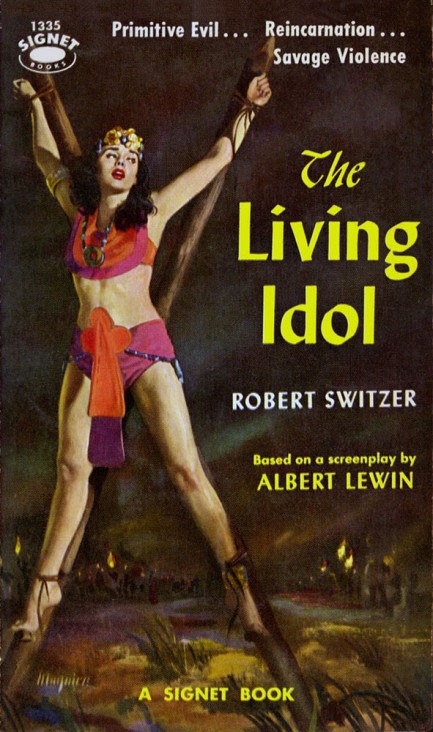 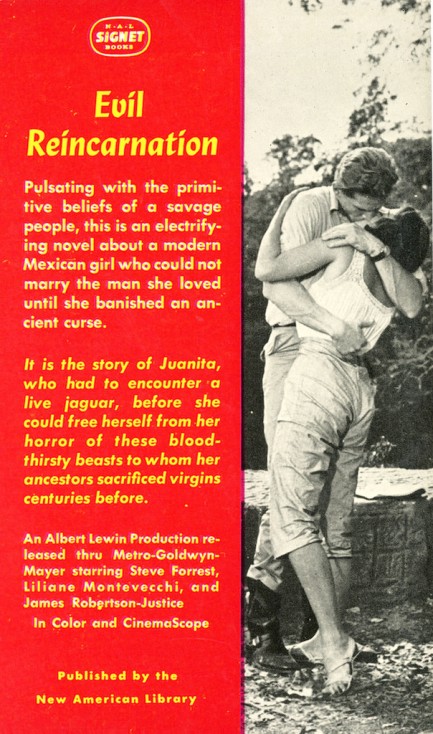
Do people still make chastity pledges? Well, if the pledge is to a cruel Aztec jaguar god that wants you to serve as his bodily vessel, don't do it. The Living Idol, which explores that precise possibility, is a novelization of a 1957 movie of the same name starring Liliane Montevecchi. We discussed it a while back. The novel came from Signet with Robert Maguire on the cover chores, and we've seen copyrights of 1956 on this, so it may have preceded the film as a means of generating interest. You can find out everything you need to know about the book by reading our bit on the movie here.
 Himes' Harlemites take the prize. 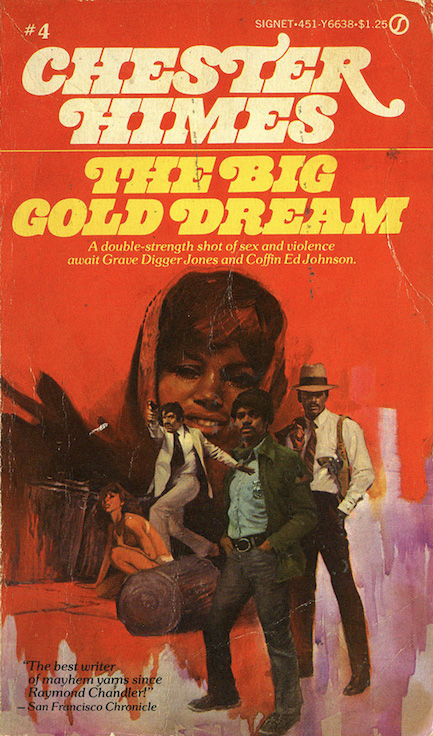
Above is an unusual orange cover by an uncredited artist for Chester Himes' crime yarn The Big Gold Dream. We're Himes fans, but for us this wasn't as enjoyable as For Love of Imabelle or The Real Cool Killers, nor as well written, in our opinion, but the author's flair is undiminished in a tale about a lottery winner whose $36,000 cash prize is stolen. The most interesting character here is Dummy, a man permanently deaf from a beating and mute from having his tongue cut out, but whose disrespectful nickname belies his tenacity. And of course franchise detectives Coffin Ed Johnson and Gravedigger Jones also star. There are caricatures many readers will find offensive, but that just makes Himes like most writers of the period. No matter what, with him you can count on a portrayal of Harlem that's quirky and insightful, and that's probably reason enough to read the book. It originally appeared in 1959, and this Signet edition dates from 1975.
 Always get out while the getting is good. 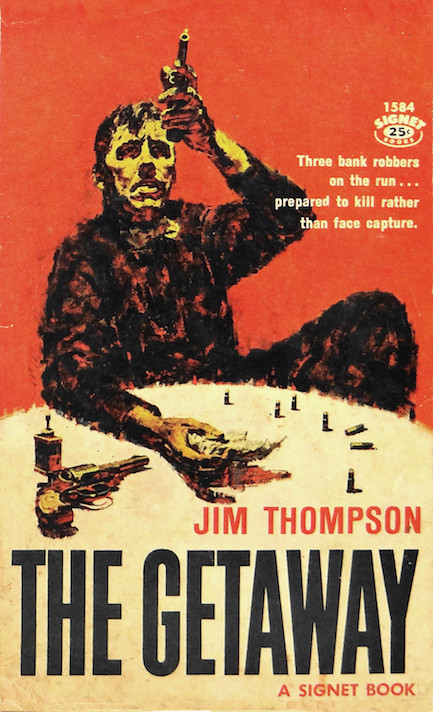
Jim Thompson's thriller The Getaway was made into a movie twice, the first time in 1972 with Steve McQueen and Ali McGraw, and the second time in 1994 with Alec Baldwin and Kim Basinger. Both versions opted to change the thrust of Thompson's tale, so if you've seen either movie reading the novel might provide an interesting experience. It's a crime novel with several deeper themes. For example, Thompson expresses social isolation in the starkest terms, such as here, when writing about a group of poor country folk:
Their existence was centered around existing. They had no hope of anything more, no comprehension that there might be anything more. In a sense they were an autonomous body, functioning within a society which was organized to grind them down. The law did not protect them; for them it was merely an instrument of harassment, a means of moving them on when it was against their interest to move, or detaining them when it was to their disadvantage to stay.
Against this hostile backdrop the two main characters, Doc and Carol, are—unlike in the movies—unambiguously amoral people, a couple who are certain only that the world is institutionally corrupt, and that their only hope for survival is each other. What starts as a standard heist-and-flight tale becomes an allegorical descent into hell, complete with images borrowed from various religious myths. This makes the latter third of the novel something far weirder than expected going in, but the ultimate idea of crime as a soul-killer comes across crystal clear.
You really can't go wrong with Thompson. While The Getaway is perhaps not as top flight as Pop. 1280 or some of his other books, it's still one to fit into your reading schedule at some point. It was originally published in 1958, and the above edition came from Signet in 1959 and features a nice orange cover from the incomparable Bob Abbett. If you're interested in seeing him at his best, check the small cover collection we put together here.
 Disturbed characters populate pointlessly offensive book about a traveling circus. 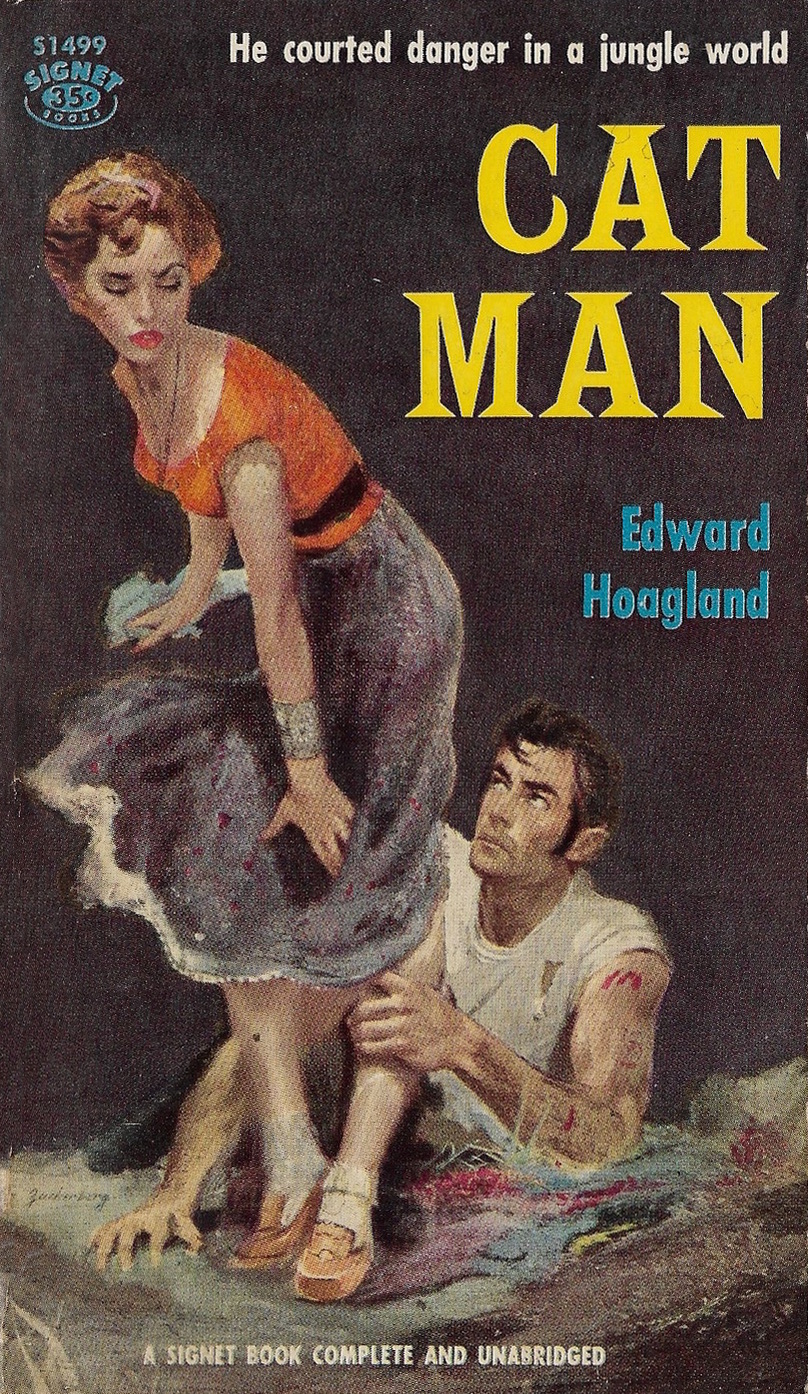
It's been a long time since we saw any cover art from Stanley Zuckerberg—almost ten years, or about fifty-seven in cat years. Zuckerberg's work fronts Edward Hoagland's Cat Man, a gritty 1958 novel that delves into the world of the traveling circus and life of the lead character who works with the big cats. Hoagland had the same job in real life for a while and he wants you to know it, which is why his book is dense with circus jargon. It's also dense with racism. If there were a point being made à la William Styron or Ben Winters, then okay, but there isn't. The novel earned some acclaim, which doesn't surprise us—pointlessly racist books often did back then. But this example is especially indefensible.
We know what some would suggest—that the attitudes on display are historical realism. But that hoary old excuse doesn't hold water, considering Hoagland takes the time to create detailed characters of Native American and Latino descent. Those portrayals are—of course—caricatures by today's standards, but Hoagland does try to make them resonate. The African-American characters, conversely, are just rabble in the background, referred to only collectively, and using the most offensive possible terminology. Worse, even some of the circus animals have names and personalities, while the black characters have neither. We're not joking. This was Hoagland's first novel and he later went on to become a respected nature essayist. Hopefully he learned something about the nature of people.
 Sorry to disappoint you, but we're into each other. 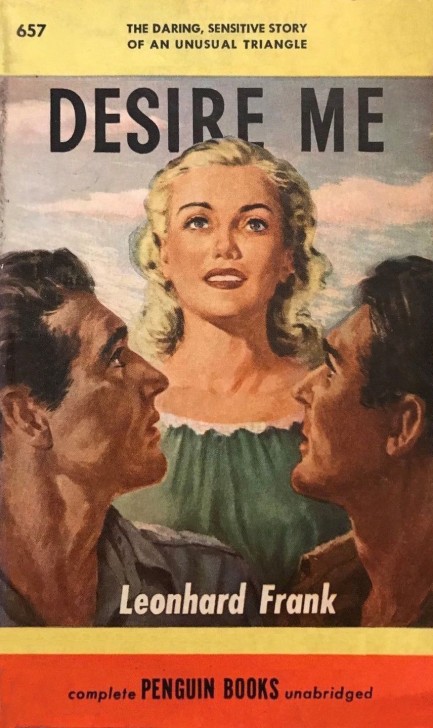
Well no, Leonhard Frank's novella Desire Me isn't about two men in love, but we think it should be, based on the cover art. It's actually a story centered around a clever idea that has been borrowed often since it was first written by Frank in 1926 as the play Karl und Anna. Basically, two men in a prison camp have plenty of idle time to get to know each other. The married prisoner speaks in detail about his wife. When the unmarried one escapes, he seeks out the married one's wife and the two fall in love. Naturally the husband, who his pal had claimed was dead, eventually resurfaces in the town to complicate matters.
This prison identity theft concept is the basis or backstory of many movies, including The House on Telegraph Hill. Returning from presumed wartime death to ruin a wife's new love affair has also been used often, notably in Casablanca. Frank was considered a leading German writer, but his legacy was destroyed when his books were burned by the Nazis before World War II. He actually wrote about this later and noted that even though Hitler lost the war, he largely succeeded in altering Germany's literary history, because many of the authors whose works were burned never regained their former stature. Frank's is a cautionary example about censorship—governments do it because it works.
 Spillane solves a tough case in more ways than one. 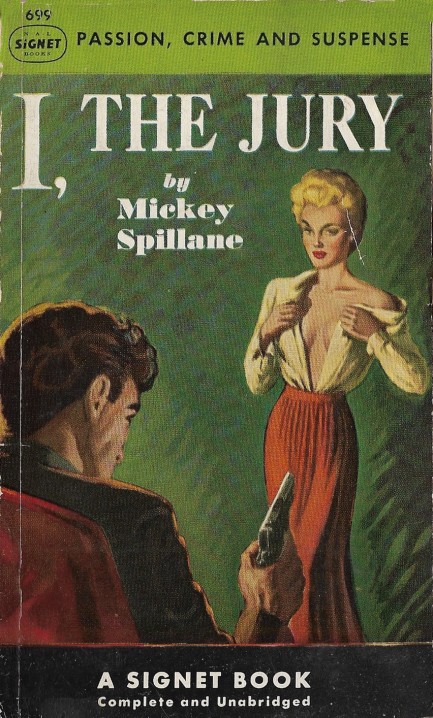
If you're on this site you almost certainly know already about Mickey Spillane's I, the Jury, so instead of talking about how it's a trailblazing hard boiled detective novel with a sledgehammer ending that's one of the most famous in pulp history, we'll share a true story with you. You know one of us went to the U.S. recently. Well, the one of us who went—PSGP—has had lots of problems getting into the country. We're talking baggage searches, being conducted to the special room for questioning, the whole deal.
Customs agents always say these stops are random but when it happens three times in five trips that's an obvious lie. Probably—and this is a guess, because we have no idea what customs agents see when they scan a passport—these stops have to do with PSGP's travel history, which includes visits to such dubious countries as Russia, Honduras, and various nations and islands in the vicinity of Cuba. One time an agent even asked him casually, “So how did that trip to Cuba work out for you?” even though there was no visa—obviously—to that effect in PSGP's passport. Columbo these agents are not.
Anyway, during one of these searches the agent in charge saw a giant pulp anthology in PSGP's luggage and immediately got all friendly, like, “Oh, you dig this kind of stuff, do you?” PSGP: “Of course.” Agent: “What do you like about it?” PSGP: “Cops, crooks, corruption, violence, you know.” Agent: “Well, you can close your bag up. I think we're done here.” Ever since then whenever PSGP goes Stateside he carries a pulp novel prominently placed on his person. And there have been no problems in customs since. Coincidence? Maybe.
But it's best to be equipped anyway, so this time he carried the above edition of I, the Jury sticking out of the breast pocket of his jacket, and customs was even smoother than usual. Also a beautiful Lufthansa flight attendant on one of the planes was even like, “Oh, passion, crime, and suspense, eh? Sounds like fun.” Yes, customs agents are soothed and even the most jaded of stews gets flirtatious when those words are sticking out of your breast pocket. So consider this a piece of advice: if you're concerned with customs carry a pulp novel, and if you carry a pulp novel, carry Spillane.
 Maybe I should have listened to my parents and stayed in community college. 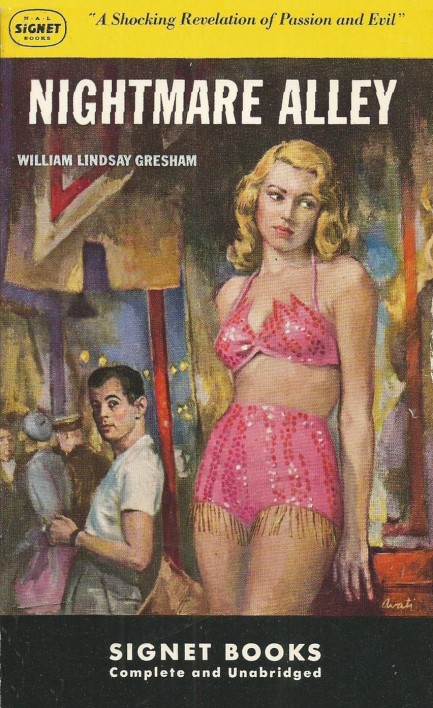
 Above, a nice James Avati cover for Nightmare Alley by William Lindsay Gresham, copyright 1949. The hardback of this came out in 1946, and it was adapted to the big screen in 1947 with Tyrone Power in the lead role, so this art reflects the movie, which is why the cover femme looks like and is dressed like co-star Coleen Gray. This is one of many mid-century novels set in and around carnivals, and it's one of the better ones, we think. The film version adheres reasonably close to Gresham's original vision. We talked about it several years ago, so check here if you're interested. We've also talked about several other carnival books over the years and now we have an idea to put together a cover collection along those lines. We'll have to see if there are any examples left to find. But in the meantime you can see what we've already collected here, here, here, and here. Above, a nice James Avati cover for Nightmare Alley by William Lindsay Gresham, copyright 1949. The hardback of this came out in 1946, and it was adapted to the big screen in 1947 with Tyrone Power in the lead role, so this art reflects the movie, which is why the cover femme looks like and is dressed like co-star Coleen Gray. This is one of many mid-century novels set in and around carnivals, and it's one of the better ones, we think. The film version adheres reasonably close to Gresham's original vision. We talked about it several years ago, so check here if you're interested. We've also talked about several other carnival books over the years and now we have an idea to put together a cover collection along those lines. We'll have to see if there are any examples left to find. But in the meantime you can see what we've already collected here, here, here, and here.
 Being good is okay, but being bad is a whole lot more fun. 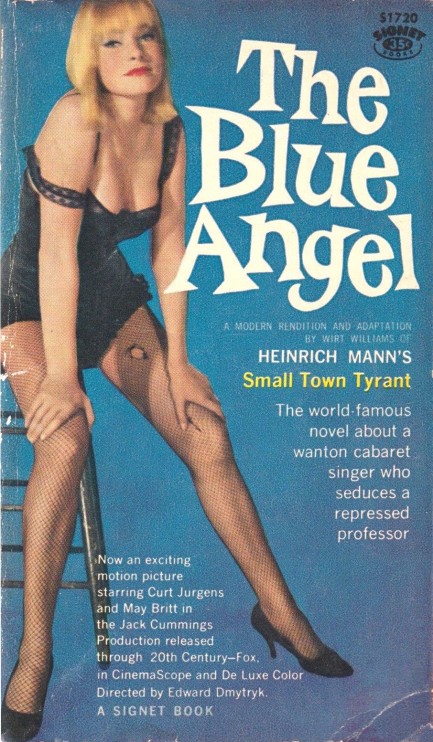
We've seen May Britt in exactly one movie but we thought she was quite good in it. That was 1959's The Blue Angel. Above you see the Signet tie-in edition of Heinrich Mann's source novel, which was called Professor Unrat when it was published in Germany in 1905. Britt fronts this paperback looking alluring but a little shabby too, which is of course what her character is all about. You can read a bit about the film here.
 The sky's the limit in third Bond thriller. 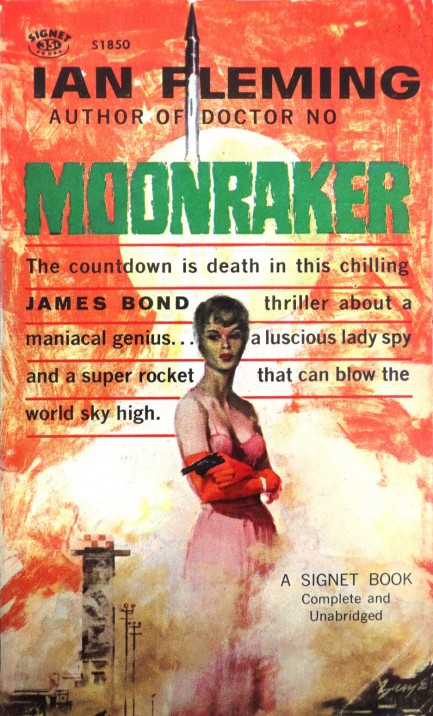
Ian Fleming's Moonraker is James Bond's third literary outing and it sees him trying to prevent the detonation of a loose nuke. If you've never read a Bond book, you may want to know that in addition to being thrillers they're hardcore car and food porn. Fleming takes pains to describe engines, exhausts, gearing; then he'll turn toward flavors, ingredients, and vintages. In Moonraker a chapter long car chase is a tour de force. A meal in a private club is almost as exciting. The rarefied world of three digit speed and three star dinners drew us in almost as much as the plot. But the main takeaway from this book for us is that it was absolutely murdered by United Artists when adapted for the screen. They left nothing but the title and the name of the villain. It's worth reading just to experience Fleming's original vision. This 1960 Signet edition has Barye Phillips cover art, and it's a bit different for him but very nice.
 Bond is born in Ian Fleming's 1953 Cold War thriller. 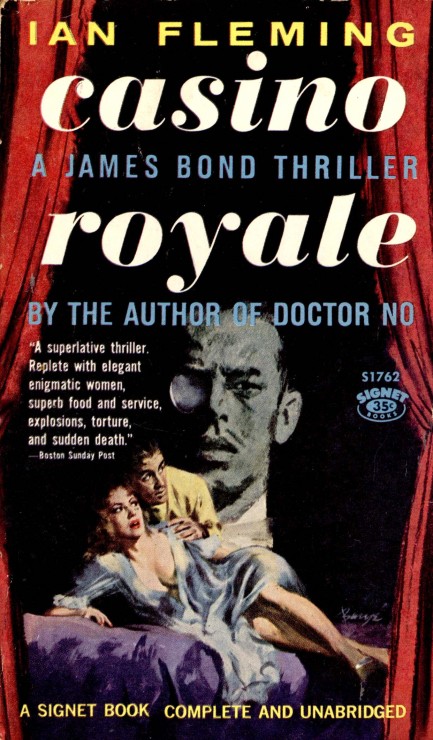
We've read a few Bond novels, but not his debut in 1953's Casino Royale. When it comes to secondhand bookstores and yard sales you read what you find. But we decided to finally make a deliberate effort to go back to the beginning with an edition from Signet, which appeared in 1960 with Barye Phillips cover art. The debuts of franchise characters leave room for continuing adventures by design but we've never read a book that was so deliberately a prequel as Casino Royale. It's the essential novel for understanding Bond. You know the basics already: Cold War intrigue, opposing teams taking the field for a long struggle, a Soviet spy named La Chiffre who's dipped into funds not his and who hatches a desperate plan to restore them via the baccarat tables of a famous French casino, Bond dispatched to outplay him, break him, and ensure his downfall for stealing the money.
The book is fantastic from its opening, through its tremendously tense middle sections, and on to its brutal punchline of an ending. Bond is imperfect as both a spy and a man. He's sometimes kind, prone to sentiment, and philosophical about his work; he's also sexist, racist, and generally regressive. Casino Royale is designed to explain how the first three qualities were destroyed, making him a perfect spy. The latter three qualities remain. While in serious fiction many authors of the period were writing about racial equality and the essential sameness of people, Ian Fleming was declaring that Asians are terrible gamblers because as a race they lack resolve. None of this is a surprise because much is known about Fleming's personal views. Bond is an icon, but of a less enlightened era. We're readers, of ours. Yet we can meet on the page, and—with a tolerance Fleming never showed others—still manage to have a little fun.
 |  |
|
 |

The headlines that mattered yesteryear.
1939—Holiday Records Strange Fruit
American blues and jazz singer Billie Holiday records "Strange Fruit", which is considered to be the first civil rights song. It began as a poem written by Abel Meeropol, which he later set to music and performed live with his wife Laura Duncan. The song became a Holiday standard immediately after she recorded it, and it remains one of the most highly regarded pieces of music in American history. 1927—Mae West Sentenced to Jail
American actress and playwright Mae West is sentenced to ten days in jail for obscenity for the content of her play Sex. The trial occurred even though the play had run for a year and had been seen by 325,000 people. However West's considerable popularity, already based on her risque image, only increased due to the controversy. 1971—Manson Sentenced to Death
In the U.S, cult leader Charles Manson is sentenced to death for inciting the murders of Sharon Tate and several other people. Three accomplices, who had actually done the killing, were also sentenced to death, but the state of California abolished capital punishment in 1972 and neither they nor Manson were ever actually executed. 1923—Yankee Stadium Opens
In New York City, Yankee Stadium, home of Major League Baseball's New York Yankees, opens with the Yankees beating their eternal rivals the Boston Red Sox 4 to 1. The stadium, which is nicknamed The House that Ruth Built, sees the Yankees become the most successful franchise in baseball history. It is eventually replaced by a new Yankee Stadium and closes in September 2008.
|

|
|

It's easy. We have an uploader that makes it a snap. Use it to submit your art, text, header, and subhead. Your post can be funny, serious, or anything in between, as long as it's vintage pulp. You'll get a byline and experience the fleeting pride of free authorship. We'll edit your post for typos, but the rest is up to you. Click here to give us your best shot.

|
|















 Above, a nice James Avati cover for Nightmare Alley by William Lindsay Gresham, copyright 1949. The hardback of this came out in 1946, and it was adapted to the big screen in 1947 with Tyrone Power in the lead role, so this art reflects the movie, which is why the cover femme looks like and is dressed like co-star Coleen Gray. This is one of many mid-century novels set in and around carnivals, and it's one of the better ones, we think. The film version adheres reasonably close to Gresham's original vision. We talked about it several years ago, so check here if you're interested. We've also talked about several other carnival books over the years and now we have an idea to put together a cover collection along those lines. We'll have to see if there are any examples left to find. But in the meantime you can see what we've already collected here, here, here, and here.
Above, a nice James Avati cover for Nightmare Alley by William Lindsay Gresham, copyright 1949. The hardback of this came out in 1946, and it was adapted to the big screen in 1947 with Tyrone Power in the lead role, so this art reflects the movie, which is why the cover femme looks like and is dressed like co-star Coleen Gray. This is one of many mid-century novels set in and around carnivals, and it's one of the better ones, we think. The film version adheres reasonably close to Gresham's original vision. We talked about it several years ago, so check here if you're interested. We've also talked about several other carnival books over the years and now we have an idea to put together a cover collection along those lines. We'll have to see if there are any examples left to find. But in the meantime you can see what we've already collected here, here, here, and here.











































































